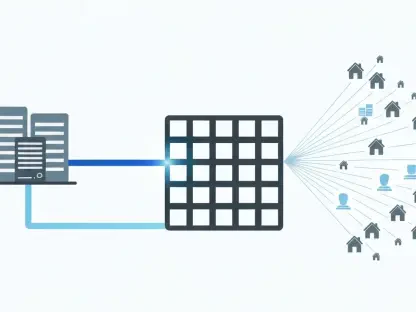Chloe Maraina is passionate about creating compelling visual stories through the analysis of big data. As a Business Intelligence expert with an aptitude for data science, Chloe has a vision for the future of data management and integration. Today, Chloe provides insights into how Digital Realty and Schneider Electric transformed Crete into a data center hub in under 12 months, focusing on the challenges, strategies, and innovations applied.
Can you describe the initial challenges of building a data center in Crete, considering its reputation as a tourist destination?
Building a data center in Crete posed significant challenges initially, mainly due to the island’s existing reputation as a tourist hotspot rather than a tech hub. This meant there were no local companies with relevant expertise, prompting us to bring in professionals from outside Greece to fill the skills gap. The lack of a local workforce skilled in data center construction and operation necessitated scanning for talent across and even beyond Greece.
How did Digital Realty address the lack of local expertise and workforce availability on the Greek island?
To tackle the challenge of workforce availability, Digital Realty brought in professionals from other parts of Greece and abroad. Collaboration with Schneider Electric was crucial here, allowing us to leverage their extensive network and experience. This approach enabled us to gather a multidisciplinary team that could meet the unique demands of the project efficiently.
Why was the decision made to use a prefabricated model for the construction of the HER1 data center?
The choice to use a prefabricated model for HER1 stemmed from multiple factors. Prefabrication allowed us to minimize the amount of equipment and materials needed onsite, reducing the environmental footprint. Moreover, building components in Barcelona and then shipping them to Crete facilitated a faster construction timeline, helping us meet pressing customer deadlines.
What are the key benefits of adopting the prefabricated approach in terms of environmental impact and construction speed?
Prefabrication significantly lowers the carbon footprint by reducing onsite activities associated with traditional construction. The streamlined process minimizes waste and enhances the use of renewable energy sources. Additionally, this approach sped up the construction process, enabling us to complete the project in under 12 months, a remarkable feat in the data center industry.
How does the central location of Crete in the Eastern Mediterranean offer advantages for subsea cable routing?
Crete’s central position in the Eastern Mediterranean makes it an ideal node for subsea cables. The strategic location allows for efficient routing to the Balkans, Greece, Turkey, and Egypt without the latency and cost incurred from detouring through more distant hubs like Marseille. This geographical advantage helps streamline content distribution and improves overall network performance.
What strategic significance does the HER1 data center hold within Digital Realty’s broader Mediterranean vision?
The HER1 data center is a pivotal element in Digital Realty’s Mediterranean strategy. It complements established hubs like Marseille by providing diversity and closer proximity to Eastern Mediterranean regions. This enables us to distribute content more efficiently, reducing latency and operational costs while supporting our vision of interconnected regional hubs.
Can you elaborate on the complementary role of Crete to other regional hubs like Marseille, Genoa, Rome, Barcelona, and Athens?
Crete plays a complementary role by bridging the gap between existing data hubs and emerging markets in the Eastern Mediterranean. While Marseille serves as a major gateway, the addition of Crete enhances content redistribution capabilities and network resilience. Each hub, including Genoa, Rome, Barcelona, and Athens, contributes uniquely, creating a robust, multi-layered network across the region.
How does the HER1 data center facilitate content distribution to the East Mediterranean regions, such as the Balkans, Greece, Turkey, and Egypt?
The HER1 data center’s strategic location allows it to act as a central point for content aggregation and redistribution. By minimizing the distance and hence latency, it ensures faster and more reliable delivery to the East Mediterranean regions. This capability is crucial for meeting the growing demand for high-speed data services in these areas.
Why did Digital Realty partner with Schneider Electric for the HER1 project, and what role did Schneider Electric play in co-designing the infrastructure?
Partnering with Schneider Electric was a strategic choice driven by their expertise in data center construction and energy management. Schneider played an integral role in co-designing the HER1 infrastructure, ensuring it met our stringent technical requirements and sustainability goals. Their collaboration encompassed design, delivery, commissioning, and ongoing maintenance support.
Could you explain the technical constraints and unique challenges faced during the HER1 data center’s development?
The primary technical constraint was delivering robust infrastructure within a tight timeframe amid skyrocketing demand. Furthermore, accommodating new use cases such as AI introduced higher power densities and required non-standard, advanced technologies. Close collaboration with customers and innovative customization enabled us to overcome these technical challenges effectively.
How are new use cases, particularly AI, influencing the design and technology of modern data centers compared to traditional ones?
AI use cases require data centers to support higher power densities and advanced cooling solutions. Unlike traditional data centers, modern facilities must cater to these evolving requirements with innovative technologies that are still maturing. This necessitates custom, ad hoc designs and meticulous planning to ensure performance and reliability.
What measures did Digital Realty and Schneider Electric take to meet skyrocketing demand and tight delivery deadlines?
Anticipation and proactive measures were key. Digital Realty and Schneider Electric increased manufacturing capacity, strengthened partner networks, and forecast requirements well in advance. Hiring and training field service representatives anticipated future needs, enabling prompt and effective installation and maintenance.
How do data centers typically operate with fewer than 10 direct employees while still driving substantial economic activity?
Data centers are designed for high efficiency, requiring minimal direct employment for operations. The real economic impact comes from our customers, who bring their own technical teams and subcontractors. Our infrastructure serves as a neutral ground for these activities, facilitating substantial economic activity and service output.
How do customer operations within data centers contribute to local economic growth?
Customer operations are vital for local economic growth as they involve substantial technical and support activities. Engineers, technicians, and subcontractors work onsite, creating jobs and driving local commerce. This ecosystem of services fosters economic development and innovation in the surrounding community.
What is Digital Realty’s approach to maintaining multi-tenant environments and ensuring efficiency in its data centers?
Digital Realty focuses on providing neutral, optimized environments that cater to diverse customer needs. By creating multi-tenant spaces with high efficiency and reliability, we ensure seamless operations and foster collaborative opportunities among tenants. Our approach prioritizes flexibility, scalability, and customer satisfaction.
Can you provide any insights into future expansions plans for Digital Realty in the southern Mediterranean region, such as Morocco and Egypt?
Our future expansion plans in the southern Mediterranean hinge on the maturity and deregulation of local markets. Prospective sites like Morocco and Egypt are under consideration, depending on their readiness and regulatory landscapes. The goal is to replicate our success in Crete and extend our footprint further.
How does Digital Realty adapt its strategy based on customer feedback and market needs?
Listening to our customers is central to our strategic adjustments. We prioritize their feedback and evolving market needs to refine our approaches continually. This responsiveness ensures we meet demand effectively and stay ahead of technological advancements, delivering optimal solutions to our clients.
In what ways does the deregulation of local markets impact data center development in various regions?
Deregulation opens up opportunities for investment and growth in new regions. It reduces barriers to entry and fosters competitive environments, facilitating data center development. As markets deregulate, we can expand our operations, driving innovation and improving infrastructure to meet global demand.
Do you have any advice for our readers?
Understanding the transformative impact of data management and integration is crucial. Embrace innovation and keep an eye on emerging trends like AI and renewable energy in data centers. Stay adaptive to market changes, and leverage collaboration to drive growth and efficiency in your endeavors.









